Near Drowning (Case Study Analysis)
VerifiedAdded on 2023/04/22
|14
|3198
|499
AI Summary
This paper introduces a 4-year old boy who suffered near drowning. Read about the assessment data, pathophysiology, medical and nursing management, education priorities and discharge plan.
Contribute Materials
Your contribution can guide someone’s learning journey. Share your
documents today.

Running head: NEAR DROWNING
Near Drowning (Case Study Analysis)
Name
Institution
Course
Date
Near Drowning (Case Study Analysis)
Name
Institution
Course
Date
Secure Best Marks with AI Grader
Need help grading? Try our AI Grader for instant feedback on your assignments.
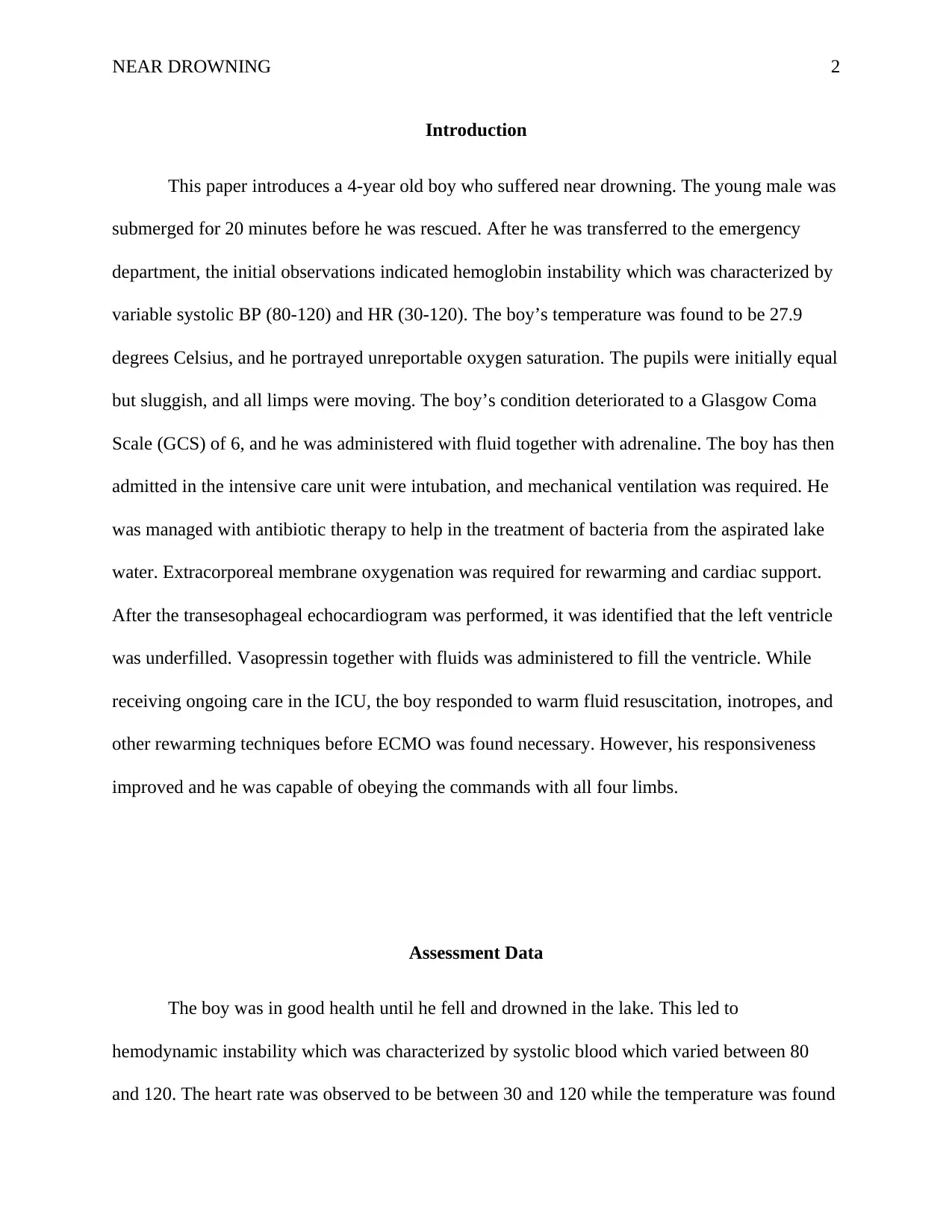
NEAR DROWNING 2
Introduction
This paper introduces a 4-year old boy who suffered near drowning. The young male was
submerged for 20 minutes before he was rescued. After he was transferred to the emergency
department, the initial observations indicated hemoglobin instability which was characterized by
variable systolic BP (80-120) and HR (30-120). The boy’s temperature was found to be 27.9
degrees Celsius, and he portrayed unreportable oxygen saturation. The pupils were initially equal
but sluggish, and all limps were moving. The boy’s condition deteriorated to a Glasgow Coma
Scale (GCS) of 6, and he was administered with fluid together with adrenaline. The boy has then
admitted in the intensive care unit were intubation, and mechanical ventilation was required. He
was managed with antibiotic therapy to help in the treatment of bacteria from the aspirated lake
water. Extracorporeal membrane oxygenation was required for rewarming and cardiac support.
After the transesophageal echocardiogram was performed, it was identified that the left ventricle
was underfilled. Vasopressin together with fluids was administered to fill the ventricle. While
receiving ongoing care in the ICU, the boy responded to warm fluid resuscitation, inotropes, and
other rewarming techniques before ECMO was found necessary. However, his responsiveness
improved and he was capable of obeying the commands with all four limbs.
Assessment Data
The boy was in good health until he fell and drowned in the lake. This led to
hemodynamic instability which was characterized by systolic blood which varied between 80
and 120. The heart rate was observed to be between 30 and 120 while the temperature was found
Introduction
This paper introduces a 4-year old boy who suffered near drowning. The young male was
submerged for 20 minutes before he was rescued. After he was transferred to the emergency
department, the initial observations indicated hemoglobin instability which was characterized by
variable systolic BP (80-120) and HR (30-120). The boy’s temperature was found to be 27.9
degrees Celsius, and he portrayed unreportable oxygen saturation. The pupils were initially equal
but sluggish, and all limps were moving. The boy’s condition deteriorated to a Glasgow Coma
Scale (GCS) of 6, and he was administered with fluid together with adrenaline. The boy has then
admitted in the intensive care unit were intubation, and mechanical ventilation was required. He
was managed with antibiotic therapy to help in the treatment of bacteria from the aspirated lake
water. Extracorporeal membrane oxygenation was required for rewarming and cardiac support.
After the transesophageal echocardiogram was performed, it was identified that the left ventricle
was underfilled. Vasopressin together with fluids was administered to fill the ventricle. While
receiving ongoing care in the ICU, the boy responded to warm fluid resuscitation, inotropes, and
other rewarming techniques before ECMO was found necessary. However, his responsiveness
improved and he was capable of obeying the commands with all four limbs.
Assessment Data
The boy was in good health until he fell and drowned in the lake. This led to
hemodynamic instability which was characterized by systolic blood which varied between 80
and 120. The heart rate was observed to be between 30 and 120 while the temperature was found
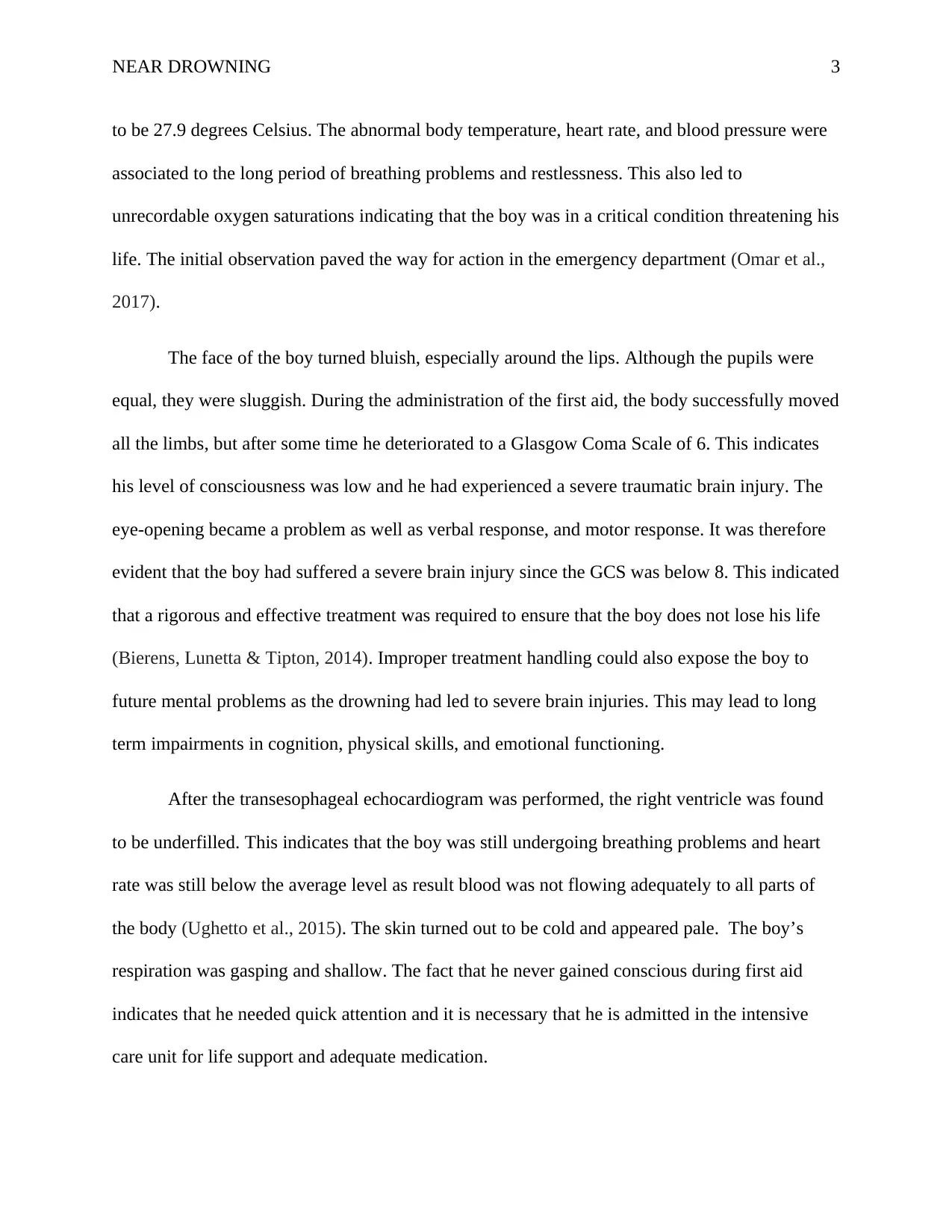
NEAR DROWNING 3
to be 27.9 degrees Celsius. The abnormal body temperature, heart rate, and blood pressure were
associated to the long period of breathing problems and restlessness. This also led to
unrecordable oxygen saturations indicating that the boy was in a critical condition threatening his
life. The initial observation paved the way for action in the emergency department (Omar et al.,
2017).
The face of the boy turned bluish, especially around the lips. Although the pupils were
equal, they were sluggish. During the administration of the first aid, the body successfully moved
all the limbs, but after some time he deteriorated to a Glasgow Coma Scale of 6. This indicates
his level of consciousness was low and he had experienced a severe traumatic brain injury. The
eye-opening became a problem as well as verbal response, and motor response. It was therefore
evident that the boy had suffered a severe brain injury since the GCS was below 8. This indicated
that a rigorous and effective treatment was required to ensure that the boy does not lose his life
(Bierens, Lunetta & Tipton, 2014). Improper treatment handling could also expose the boy to
future mental problems as the drowning had led to severe brain injuries. This may lead to long
term impairments in cognition, physical skills, and emotional functioning.
After the transesophageal echocardiogram was performed, the right ventricle was found
to be underfilled. This indicates that the boy was still undergoing breathing problems and heart
rate was still below the average level as result blood was not flowing adequately to all parts of
the body (Ughetto et al., 2015). The skin turned out to be cold and appeared pale. The boy’s
respiration was gasping and shallow. The fact that he never gained conscious during first aid
indicates that he needed quick attention and it is necessary that he is admitted in the intensive
care unit for life support and adequate medication.
to be 27.9 degrees Celsius. The abnormal body temperature, heart rate, and blood pressure were
associated to the long period of breathing problems and restlessness. This also led to
unrecordable oxygen saturations indicating that the boy was in a critical condition threatening his
life. The initial observation paved the way for action in the emergency department (Omar et al.,
2017).
The face of the boy turned bluish, especially around the lips. Although the pupils were
equal, they were sluggish. During the administration of the first aid, the body successfully moved
all the limbs, but after some time he deteriorated to a Glasgow Coma Scale of 6. This indicates
his level of consciousness was low and he had experienced a severe traumatic brain injury. The
eye-opening became a problem as well as verbal response, and motor response. It was therefore
evident that the boy had suffered a severe brain injury since the GCS was below 8. This indicated
that a rigorous and effective treatment was required to ensure that the boy does not lose his life
(Bierens, Lunetta & Tipton, 2014). Improper treatment handling could also expose the boy to
future mental problems as the drowning had led to severe brain injuries. This may lead to long
term impairments in cognition, physical skills, and emotional functioning.
After the transesophageal echocardiogram was performed, the right ventricle was found
to be underfilled. This indicates that the boy was still undergoing breathing problems and heart
rate was still below the average level as result blood was not flowing adequately to all parts of
the body (Ughetto et al., 2015). The skin turned out to be cold and appeared pale. The boy’s
respiration was gasping and shallow. The fact that he never gained conscious during first aid
indicates that he needed quick attention and it is necessary that he is admitted in the intensive
care unit for life support and adequate medication.
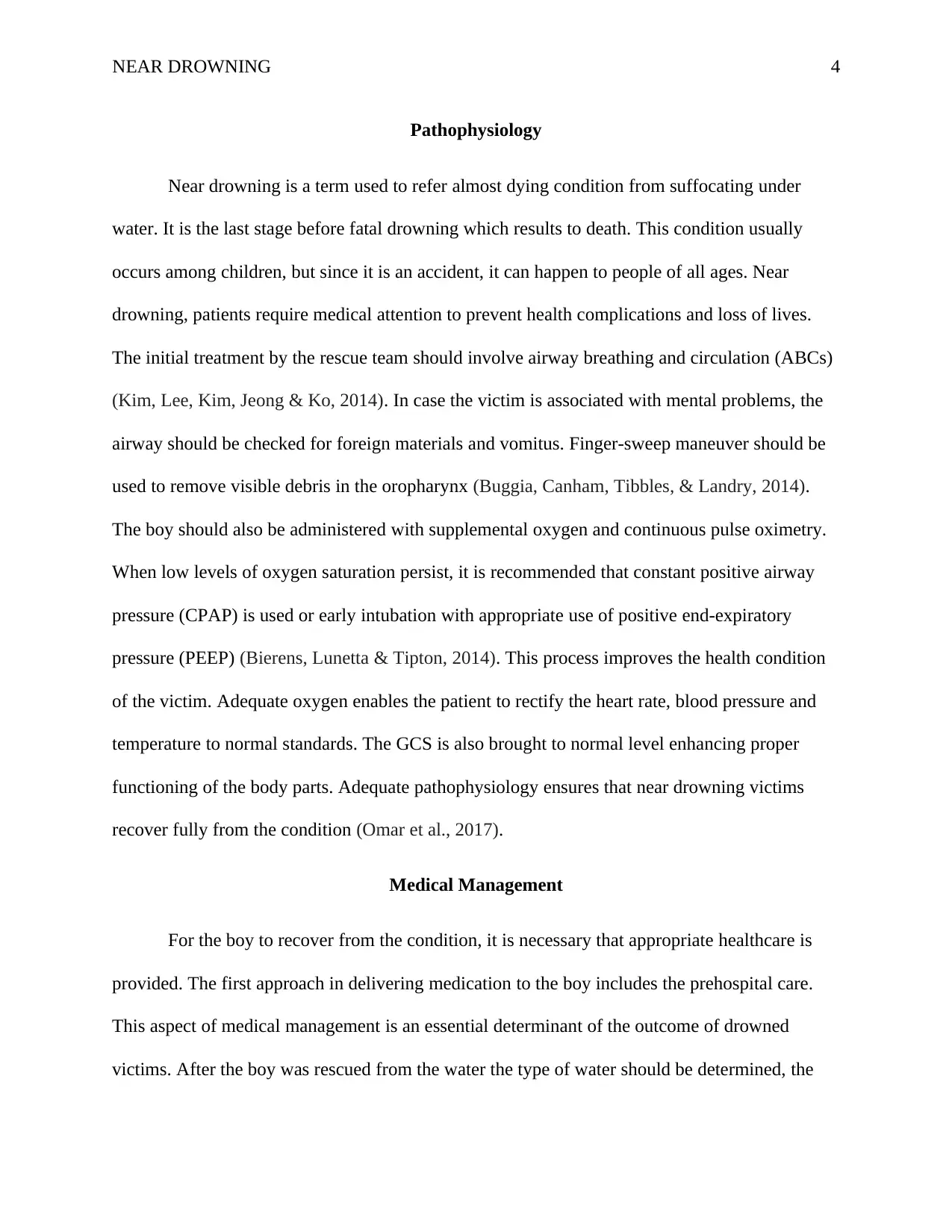
NEAR DROWNING 4
Pathophysiology
Near drowning is a term used to refer almost dying condition from suffocating under
water. It is the last stage before fatal drowning which results to death. This condition usually
occurs among children, but since it is an accident, it can happen to people of all ages. Near
drowning, patients require medical attention to prevent health complications and loss of lives.
The initial treatment by the rescue team should involve airway breathing and circulation (ABCs)
(Kim, Lee, Kim, Jeong & Ko, 2014). In case the victim is associated with mental problems, the
airway should be checked for foreign materials and vomitus. Finger-sweep maneuver should be
used to remove visible debris in the oropharynx (Buggia, Canham, Tibbles, & Landry, 2014).
The boy should also be administered with supplemental oxygen and continuous pulse oximetry.
When low levels of oxygen saturation persist, it is recommended that constant positive airway
pressure (CPAP) is used or early intubation with appropriate use of positive end-expiratory
pressure (PEEP) (Bierens, Lunetta & Tipton, 2014). This process improves the health condition
of the victim. Adequate oxygen enables the patient to rectify the heart rate, blood pressure and
temperature to normal standards. The GCS is also brought to normal level enhancing proper
functioning of the body parts. Adequate pathophysiology ensures that near drowning victims
recover fully from the condition (Omar et al., 2017).
Medical Management
For the boy to recover from the condition, it is necessary that appropriate healthcare is
provided. The first approach in delivering medication to the boy includes the prehospital care.
This aspect of medical management is an essential determinant of the outcome of drowned
victims. After the boy was rescued from the water the type of water should be determined, the
Pathophysiology
Near drowning is a term used to refer almost dying condition from suffocating under
water. It is the last stage before fatal drowning which results to death. This condition usually
occurs among children, but since it is an accident, it can happen to people of all ages. Near
drowning, patients require medical attention to prevent health complications and loss of lives.
The initial treatment by the rescue team should involve airway breathing and circulation (ABCs)
(Kim, Lee, Kim, Jeong & Ko, 2014). In case the victim is associated with mental problems, the
airway should be checked for foreign materials and vomitus. Finger-sweep maneuver should be
used to remove visible debris in the oropharynx (Buggia, Canham, Tibbles, & Landry, 2014).
The boy should also be administered with supplemental oxygen and continuous pulse oximetry.
When low levels of oxygen saturation persist, it is recommended that constant positive airway
pressure (CPAP) is used or early intubation with appropriate use of positive end-expiratory
pressure (PEEP) (Bierens, Lunetta & Tipton, 2014). This process improves the health condition
of the victim. Adequate oxygen enables the patient to rectify the heart rate, blood pressure and
temperature to normal standards. The GCS is also brought to normal level enhancing proper
functioning of the body parts. Adequate pathophysiology ensures that near drowning victims
recover fully from the condition (Omar et al., 2017).
Medical Management
For the boy to recover from the condition, it is necessary that appropriate healthcare is
provided. The first approach in delivering medication to the boy includes the prehospital care.
This aspect of medical management is an essential determinant of the outcome of drowned
victims. After the boy was rescued from the water the type of water should be determined, the
Secure Best Marks with AI Grader
Need help grading? Try our AI Grader for instant feedback on your assignments.
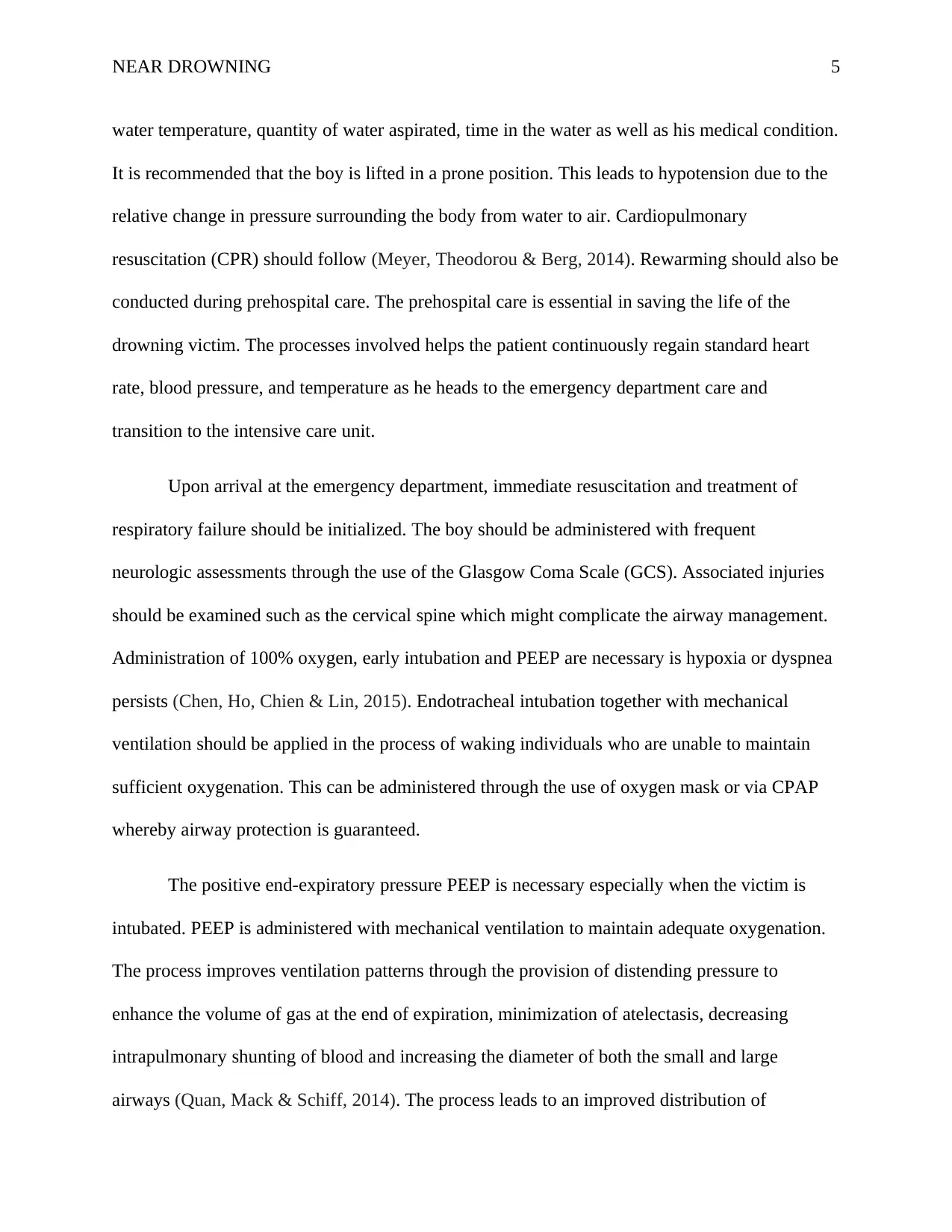
NEAR DROWNING 5
water temperature, quantity of water aspirated, time in the water as well as his medical condition.
It is recommended that the boy is lifted in a prone position. This leads to hypotension due to the
relative change in pressure surrounding the body from water to air. Cardiopulmonary
resuscitation (CPR) should follow (Meyer, Theodorou & Berg, 2014). Rewarming should also be
conducted during prehospital care. The prehospital care is essential in saving the life of the
drowning victim. The processes involved helps the patient continuously regain standard heart
rate, blood pressure, and temperature as he heads to the emergency department care and
transition to the intensive care unit.
Upon arrival at the emergency department, immediate resuscitation and treatment of
respiratory failure should be initialized. The boy should be administered with frequent
neurologic assessments through the use of the Glasgow Coma Scale (GCS). Associated injuries
should be examined such as the cervical spine which might complicate the airway management.
Administration of 100% oxygen, early intubation and PEEP are necessary is hypoxia or dyspnea
persists (Chen, Ho, Chien & Lin, 2015). Endotracheal intubation together with mechanical
ventilation should be applied in the process of waking individuals who are unable to maintain
sufficient oxygenation. This can be administered through the use of oxygen mask or via CPAP
whereby airway protection is guaranteed.
The positive end-expiratory pressure PEEP is necessary especially when the victim is
intubated. PEEP is administered with mechanical ventilation to maintain adequate oxygenation.
The process improves ventilation patterns through the provision of distending pressure to
enhance the volume of gas at the end of expiration, minimization of atelectasis, decreasing
intrapulmonary shunting of blood and increasing the diameter of both the small and large
airways (Quan, Mack & Schiff, 2014). The process leads to an improved distribution of
water temperature, quantity of water aspirated, time in the water as well as his medical condition.
It is recommended that the boy is lifted in a prone position. This leads to hypotension due to the
relative change in pressure surrounding the body from water to air. Cardiopulmonary
resuscitation (CPR) should follow (Meyer, Theodorou & Berg, 2014). Rewarming should also be
conducted during prehospital care. The prehospital care is essential in saving the life of the
drowning victim. The processes involved helps the patient continuously regain standard heart
rate, blood pressure, and temperature as he heads to the emergency department care and
transition to the intensive care unit.
Upon arrival at the emergency department, immediate resuscitation and treatment of
respiratory failure should be initialized. The boy should be administered with frequent
neurologic assessments through the use of the Glasgow Coma Scale (GCS). Associated injuries
should be examined such as the cervical spine which might complicate the airway management.
Administration of 100% oxygen, early intubation and PEEP are necessary is hypoxia or dyspnea
persists (Chen, Ho, Chien & Lin, 2015). Endotracheal intubation together with mechanical
ventilation should be applied in the process of waking individuals who are unable to maintain
sufficient oxygenation. This can be administered through the use of oxygen mask or via CPAP
whereby airway protection is guaranteed.
The positive end-expiratory pressure PEEP is necessary especially when the victim is
intubated. PEEP is administered with mechanical ventilation to maintain adequate oxygenation.
The process improves ventilation patterns through the provision of distending pressure to
enhance the volume of gas at the end of expiration, minimization of atelectasis, decreasing
intrapulmonary shunting of blood and increasing the diameter of both the small and large
airways (Quan, Mack & Schiff, 2014). The process leads to an improved distribution of
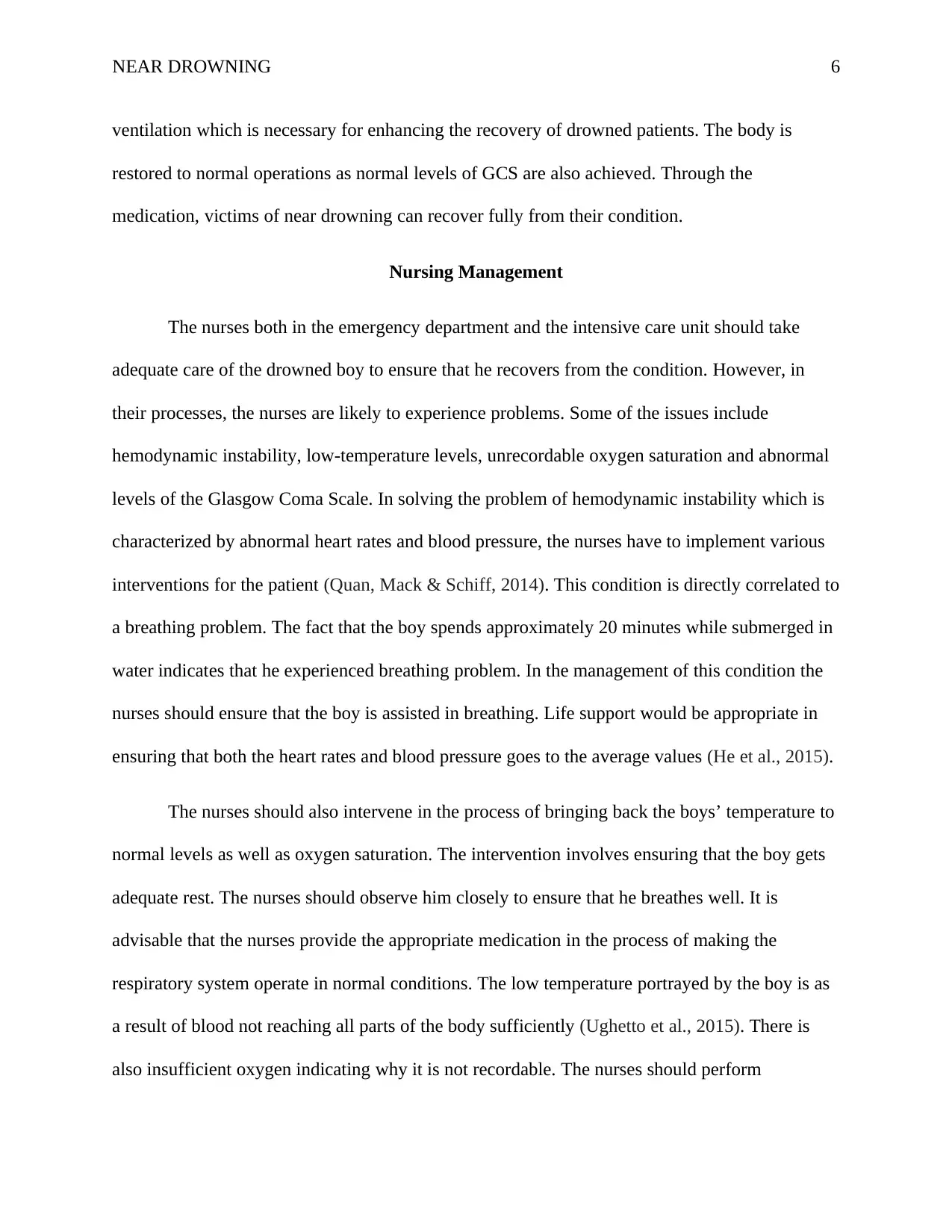
NEAR DROWNING 6
ventilation which is necessary for enhancing the recovery of drowned patients. The body is
restored to normal operations as normal levels of GCS are also achieved. Through the
medication, victims of near drowning can recover fully from their condition.
Nursing Management
The nurses both in the emergency department and the intensive care unit should take
adequate care of the drowned boy to ensure that he recovers from the condition. However, in
their processes, the nurses are likely to experience problems. Some of the issues include
hemodynamic instability, low-temperature levels, unrecordable oxygen saturation and abnormal
levels of the Glasgow Coma Scale. In solving the problem of hemodynamic instability which is
characterized by abnormal heart rates and blood pressure, the nurses have to implement various
interventions for the patient (Quan, Mack & Schiff, 2014). This condition is directly correlated to
a breathing problem. The fact that the boy spends approximately 20 minutes while submerged in
water indicates that he experienced breathing problem. In the management of this condition the
nurses should ensure that the boy is assisted in breathing. Life support would be appropriate in
ensuring that both the heart rates and blood pressure goes to the average values (He et al., 2015).
The nurses should also intervene in the process of bringing back the boys’ temperature to
normal levels as well as oxygen saturation. The intervention involves ensuring that the boy gets
adequate rest. The nurses should observe him closely to ensure that he breathes well. It is
advisable that the nurses provide the appropriate medication in the process of making the
respiratory system operate in normal conditions. The low temperature portrayed by the boy is as
a result of blood not reaching all parts of the body sufficiently (Ughetto et al., 2015). There is
also insufficient oxygen indicating why it is not recordable. The nurses should perform
ventilation which is necessary for enhancing the recovery of drowned patients. The body is
restored to normal operations as normal levels of GCS are also achieved. Through the
medication, victims of near drowning can recover fully from their condition.
Nursing Management
The nurses both in the emergency department and the intensive care unit should take
adequate care of the drowned boy to ensure that he recovers from the condition. However, in
their processes, the nurses are likely to experience problems. Some of the issues include
hemodynamic instability, low-temperature levels, unrecordable oxygen saturation and abnormal
levels of the Glasgow Coma Scale. In solving the problem of hemodynamic instability which is
characterized by abnormal heart rates and blood pressure, the nurses have to implement various
interventions for the patient (Quan, Mack & Schiff, 2014). This condition is directly correlated to
a breathing problem. The fact that the boy spends approximately 20 minutes while submerged in
water indicates that he experienced breathing problem. In the management of this condition the
nurses should ensure that the boy is assisted in breathing. Life support would be appropriate in
ensuring that both the heart rates and blood pressure goes to the average values (He et al., 2015).
The nurses should also intervene in the process of bringing back the boys’ temperature to
normal levels as well as oxygen saturation. The intervention involves ensuring that the boy gets
adequate rest. The nurses should observe him closely to ensure that he breathes well. It is
advisable that the nurses provide the appropriate medication in the process of making the
respiratory system operate in normal conditions. The low temperature portrayed by the boy is as
a result of blood not reaching all parts of the body sufficiently (Ughetto et al., 2015). There is
also insufficient oxygen indicating why it is not recordable. The nurses should perform
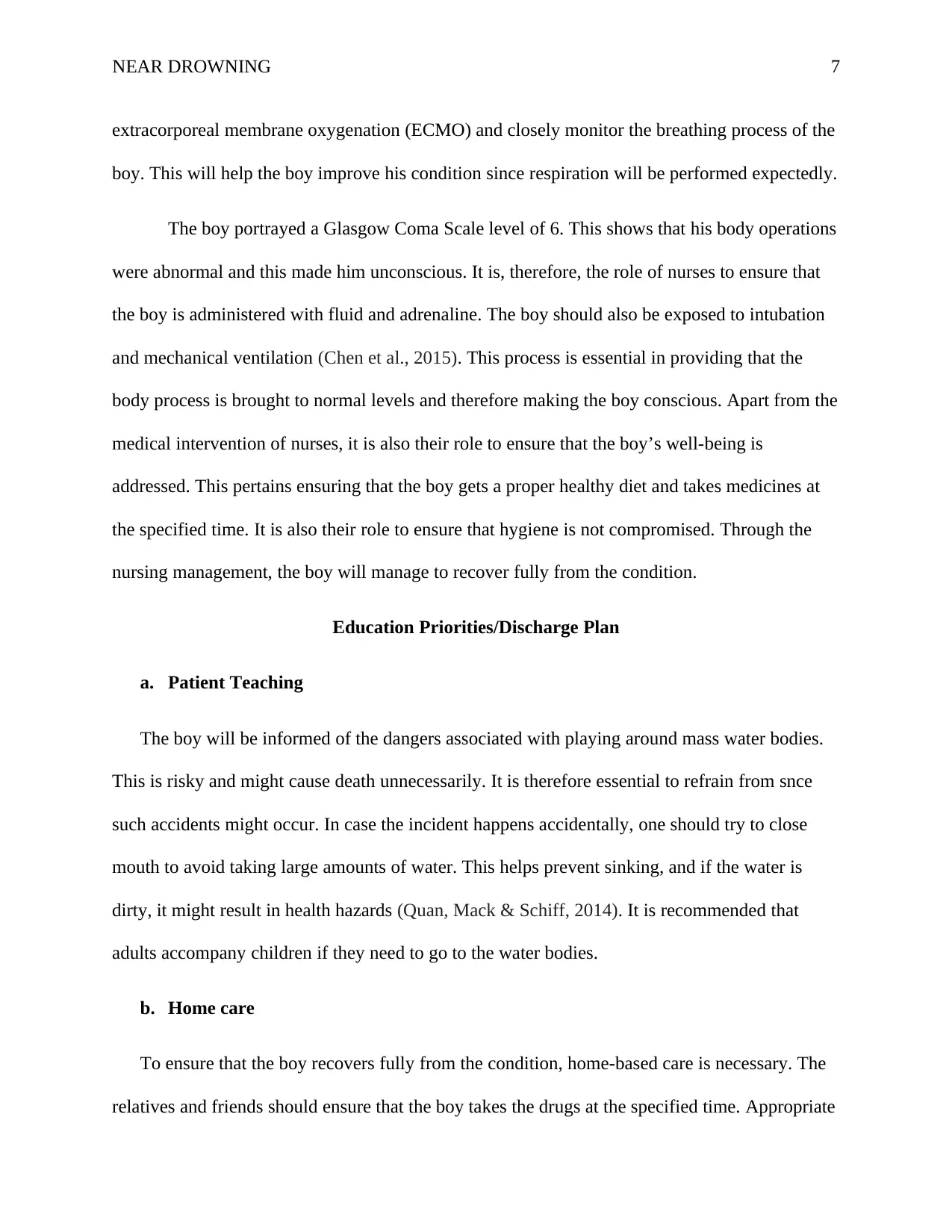
NEAR DROWNING 7
extracorporeal membrane oxygenation (ECMO) and closely monitor the breathing process of the
boy. This will help the boy improve his condition since respiration will be performed expectedly.
The boy portrayed a Glasgow Coma Scale level of 6. This shows that his body operations
were abnormal and this made him unconscious. It is, therefore, the role of nurses to ensure that
the boy is administered with fluid and adrenaline. The boy should also be exposed to intubation
and mechanical ventilation (Chen et al., 2015). This process is essential in providing that the
body process is brought to normal levels and therefore making the boy conscious. Apart from the
medical intervention of nurses, it is also their role to ensure that the boy’s well-being is
addressed. This pertains ensuring that the boy gets a proper healthy diet and takes medicines at
the specified time. It is also their role to ensure that hygiene is not compromised. Through the
nursing management, the boy will manage to recover fully from the condition.
Education Priorities/Discharge Plan
a. Patient Teaching
The boy will be informed of the dangers associated with playing around mass water bodies.
This is risky and might cause death unnecessarily. It is therefore essential to refrain from snce
such accidents might occur. In case the incident happens accidentally, one should try to close
mouth to avoid taking large amounts of water. This helps prevent sinking, and if the water is
dirty, it might result in health hazards (Quan, Mack & Schiff, 2014). It is recommended that
adults accompany children if they need to go to the water bodies.
b. Home care
To ensure that the boy recovers fully from the condition, home-based care is necessary. The
relatives and friends should ensure that the boy takes the drugs at the specified time. Appropriate
extracorporeal membrane oxygenation (ECMO) and closely monitor the breathing process of the
boy. This will help the boy improve his condition since respiration will be performed expectedly.
The boy portrayed a Glasgow Coma Scale level of 6. This shows that his body operations
were abnormal and this made him unconscious. It is, therefore, the role of nurses to ensure that
the boy is administered with fluid and adrenaline. The boy should also be exposed to intubation
and mechanical ventilation (Chen et al., 2015). This process is essential in providing that the
body process is brought to normal levels and therefore making the boy conscious. Apart from the
medical intervention of nurses, it is also their role to ensure that the boy’s well-being is
addressed. This pertains ensuring that the boy gets a proper healthy diet and takes medicines at
the specified time. It is also their role to ensure that hygiene is not compromised. Through the
nursing management, the boy will manage to recover fully from the condition.
Education Priorities/Discharge Plan
a. Patient Teaching
The boy will be informed of the dangers associated with playing around mass water bodies.
This is risky and might cause death unnecessarily. It is therefore essential to refrain from snce
such accidents might occur. In case the incident happens accidentally, one should try to close
mouth to avoid taking large amounts of water. This helps prevent sinking, and if the water is
dirty, it might result in health hazards (Quan, Mack & Schiff, 2014). It is recommended that
adults accompany children if they need to go to the water bodies.
b. Home care
To ensure that the boy recovers fully from the condition, home-based care is necessary. The
relatives and friends should ensure that the boy takes the drugs at the specified time. Appropriate
Paraphrase This Document
Need a fresh take? Get an instant paraphrase of this document with our AI Paraphraser
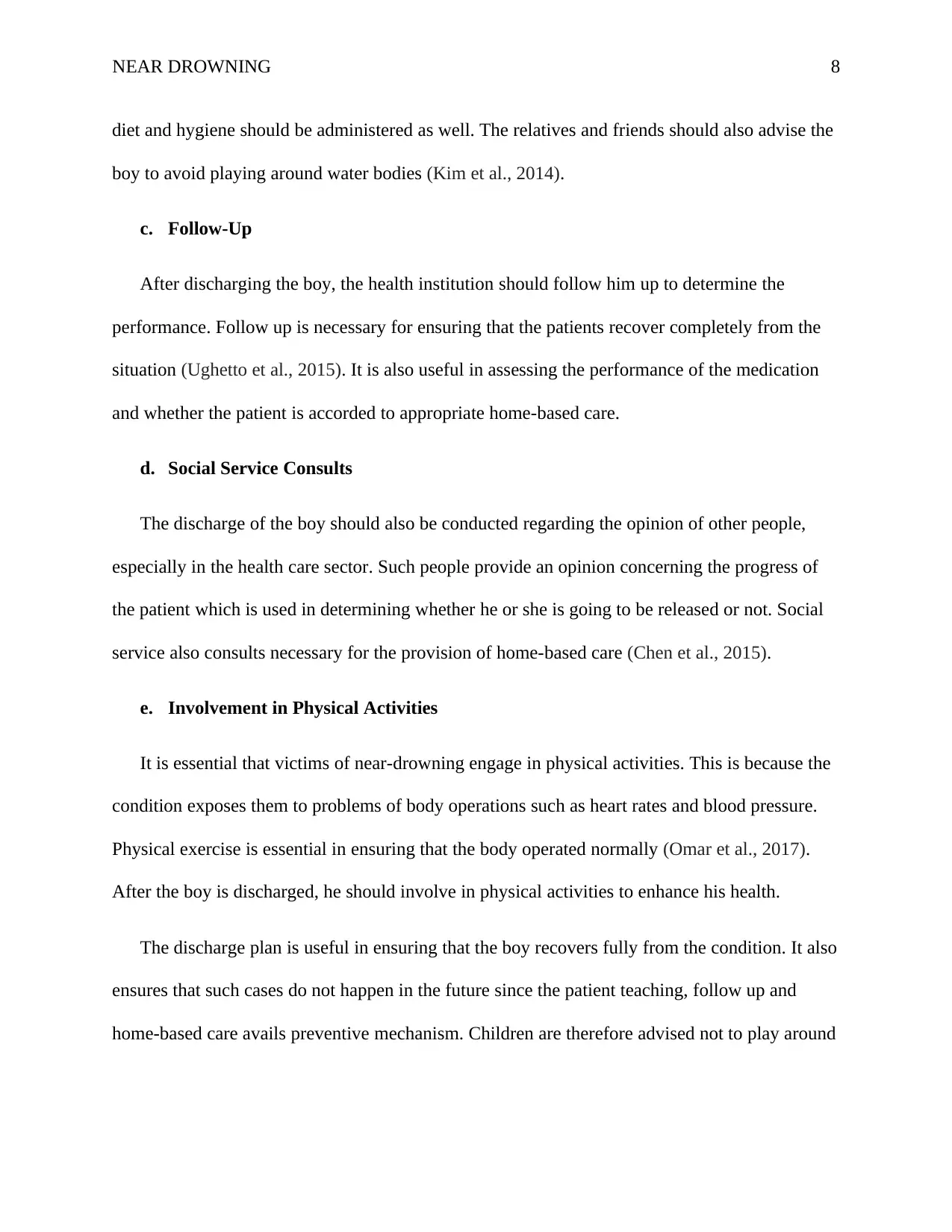
NEAR DROWNING 8
diet and hygiene should be administered as well. The relatives and friends should also advise the
boy to avoid playing around water bodies (Kim et al., 2014).
c. Follow-Up
After discharging the boy, the health institution should follow him up to determine the
performance. Follow up is necessary for ensuring that the patients recover completely from the
situation (Ughetto et al., 2015). It is also useful in assessing the performance of the medication
and whether the patient is accorded to appropriate home-based care.
d. Social Service Consults
The discharge of the boy should also be conducted regarding the opinion of other people,
especially in the health care sector. Such people provide an opinion concerning the progress of
the patient which is used in determining whether he or she is going to be released or not. Social
service also consults necessary for the provision of home-based care (Chen et al., 2015).
e. Involvement in Physical Activities
It is essential that victims of near-drowning engage in physical activities. This is because the
condition exposes them to problems of body operations such as heart rates and blood pressure.
Physical exercise is essential in ensuring that the body operated normally (Omar et al., 2017).
After the boy is discharged, he should involve in physical activities to enhance his health.
The discharge plan is useful in ensuring that the boy recovers fully from the condition. It also
ensures that such cases do not happen in the future since the patient teaching, follow up and
home-based care avails preventive mechanism. Children are therefore advised not to play around
diet and hygiene should be administered as well. The relatives and friends should also advise the
boy to avoid playing around water bodies (Kim et al., 2014).
c. Follow-Up
After discharging the boy, the health institution should follow him up to determine the
performance. Follow up is necessary for ensuring that the patients recover completely from the
situation (Ughetto et al., 2015). It is also useful in assessing the performance of the medication
and whether the patient is accorded to appropriate home-based care.
d. Social Service Consults
The discharge of the boy should also be conducted regarding the opinion of other people,
especially in the health care sector. Such people provide an opinion concerning the progress of
the patient which is used in determining whether he or she is going to be released or not. Social
service also consults necessary for the provision of home-based care (Chen et al., 2015).
e. Involvement in Physical Activities
It is essential that victims of near-drowning engage in physical activities. This is because the
condition exposes them to problems of body operations such as heart rates and blood pressure.
Physical exercise is essential in ensuring that the body operated normally (Omar et al., 2017).
After the boy is discharged, he should involve in physical activities to enhance his health.
The discharge plan is useful in ensuring that the boy recovers fully from the condition. It also
ensures that such cases do not happen in the future since the patient teaching, follow up and
home-based care avails preventive mechanism. Children are therefore advised not to play around

NEAR DROWNING 9
water bodies as such accidents might occur threatening their lives. After discharge, it is
recommended that one engages in physical activities since it is essential for the body.
water bodies as such accidents might occur threatening their lives. After discharge, it is
recommended that one engages in physical activities since it is essential for the body.
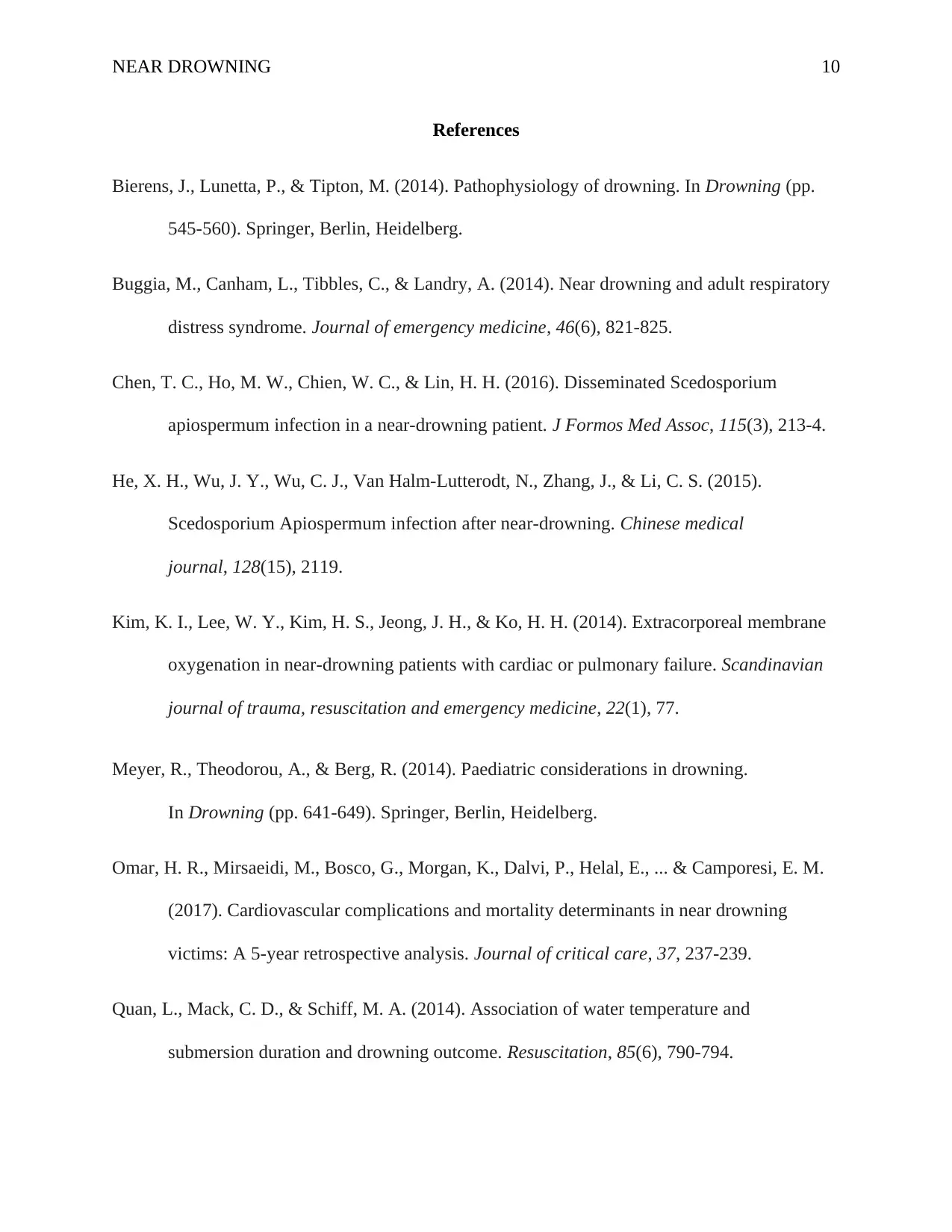
NEAR DROWNING 10
References
Bierens, J., Lunetta, P., & Tipton, M. (2014). Pathophysiology of drowning. In Drowning (pp.
545-560). Springer, Berlin, Heidelberg.
Buggia, M., Canham, L., Tibbles, C., & Landry, A. (2014). Near drowning and adult respiratory
distress syndrome. Journal of emergency medicine, 46(6), 821-825.
Chen, T. C., Ho, M. W., Chien, W. C., & Lin, H. H. (2016). Disseminated Scedosporium
apiospermum infection in a near-drowning patient. J Formos Med Assoc, 115(3), 213-4.
He, X. H., Wu, J. Y., Wu, C. J., Van Halm-Lutterodt, N., Zhang, J., & Li, C. S. (2015).
Scedosporium Apiospermum infection after near-drowning. Chinese medical
journal, 128(15), 2119.
Kim, K. I., Lee, W. Y., Kim, H. S., Jeong, J. H., & Ko, H. H. (2014). Extracorporeal membrane
oxygenation in near-drowning patients with cardiac or pulmonary failure. Scandinavian
journal of trauma, resuscitation and emergency medicine, 22(1), 77.
Meyer, R., Theodorou, A., & Berg, R. (2014). Paediatric considerations in drowning.
In Drowning (pp. 641-649). Springer, Berlin, Heidelberg.
Omar, H. R., Mirsaeidi, M., Bosco, G., Morgan, K., Dalvi, P., Helal, E., ... & Camporesi, E. M.
(2017). Cardiovascular complications and mortality determinants in near drowning
victims: A 5-year retrospective analysis. Journal of critical care, 37, 237-239.
Quan, L., Mack, C. D., & Schiff, M. A. (2014). Association of water temperature and
submersion duration and drowning outcome. Resuscitation, 85(6), 790-794.
References
Bierens, J., Lunetta, P., & Tipton, M. (2014). Pathophysiology of drowning. In Drowning (pp.
545-560). Springer, Berlin, Heidelberg.
Buggia, M., Canham, L., Tibbles, C., & Landry, A. (2014). Near drowning and adult respiratory
distress syndrome. Journal of emergency medicine, 46(6), 821-825.
Chen, T. C., Ho, M. W., Chien, W. C., & Lin, H. H. (2016). Disseminated Scedosporium
apiospermum infection in a near-drowning patient. J Formos Med Assoc, 115(3), 213-4.
He, X. H., Wu, J. Y., Wu, C. J., Van Halm-Lutterodt, N., Zhang, J., & Li, C. S. (2015).
Scedosporium Apiospermum infection after near-drowning. Chinese medical
journal, 128(15), 2119.
Kim, K. I., Lee, W. Y., Kim, H. S., Jeong, J. H., & Ko, H. H. (2014). Extracorporeal membrane
oxygenation in near-drowning patients with cardiac or pulmonary failure. Scandinavian
journal of trauma, resuscitation and emergency medicine, 22(1), 77.
Meyer, R., Theodorou, A., & Berg, R. (2014). Paediatric considerations in drowning.
In Drowning (pp. 641-649). Springer, Berlin, Heidelberg.
Omar, H. R., Mirsaeidi, M., Bosco, G., Morgan, K., Dalvi, P., Helal, E., ... & Camporesi, E. M.
(2017). Cardiovascular complications and mortality determinants in near drowning
victims: A 5-year retrospective analysis. Journal of critical care, 37, 237-239.
Quan, L., Mack, C. D., & Schiff, M. A. (2014). Association of water temperature and
submersion duration and drowning outcome. Resuscitation, 85(6), 790-794.
Secure Best Marks with AI Grader
Need help grading? Try our AI Grader for instant feedback on your assignments.

NEAR DROWNING 11
Ughetto, E., Héry-Arnaud, G., Cariou, M. E., Pelloux, I., Maurin, M., Caillon, J., ... & Corvec, S.
(2015). An original case of Francisella tularensis subsp. holarctica bacteremia after a
near-drowning accident. Infectious Diseases, 47(8), 588-590.
Ughetto, E., Héry-Arnaud, G., Cariou, M. E., Pelloux, I., Maurin, M., Caillon, J., ... & Corvec, S.
(2015). An original case of Francisella tularensis subsp. holarctica bacteremia after a
near-drowning accident. Infectious Diseases, 47(8), 588-590.
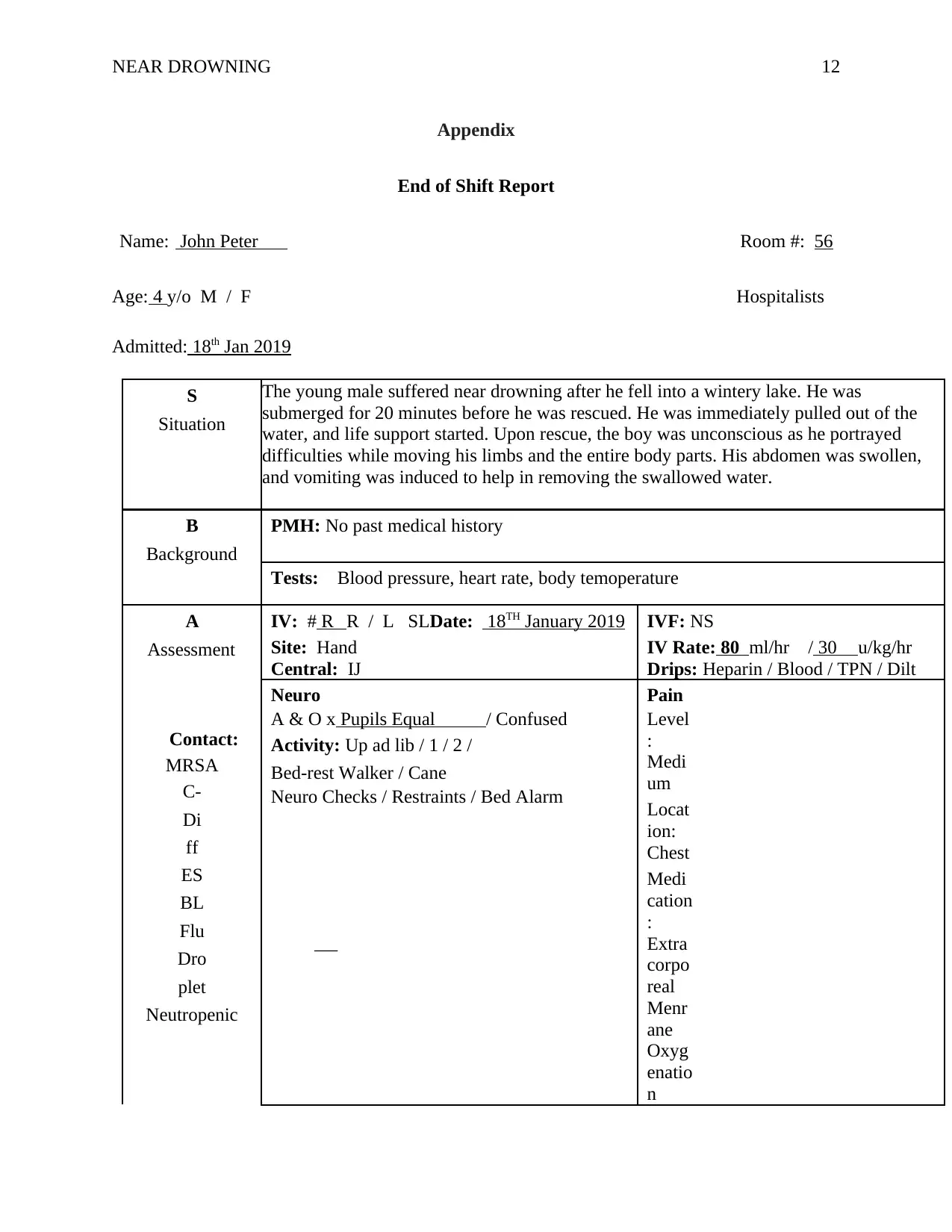
NEAR DROWNING 12
Appendix
End of Shift Report
Name: John Peter Room #: 56
Age: 4 y/o M / F Hospitalists
Admitted: 18th Jan 2019
S
Situation
The young male suffered near drowning after he fell into a wintery lake. He was
submerged for 20 minutes before he was rescued. He was immediately pulled out of the
water, and life support started. Upon rescue, the boy was unconscious as he portrayed
difficulties while moving his limbs and the entire body parts. His abdomen was swollen,
and vomiting was induced to help in removing the swallowed water.
B
Background
PMH: No past medical history
Tests: Blood pressure, heart rate, body temoperature
A
Assessment
IV: # R R / L SLDate: 18TH January 2019
Site: Hand
Central: IJ
IVF: NS
IV Rate: 80 ml/hr / 30 u/kg/hr
Drips: Heparin / Blood / TPN / Dilt
Neuro Pain
Contact:
MRSA
C-
Di
ff
ES
BL
Flu
Dro
plet
Neutropenic
A & O x Pupils Equal / Confused
Activity: Up ad lib / 1 / 2 /
Bed-rest Walker / Cane
Neuro Checks / Restraints / Bed Alarm
Level
:
Medi
um
Locat
ion:
Chest
Medi
cation
:
Extra
corpo
real
Menr
ane
Oxyg
enatio
n
Appendix
End of Shift Report
Name: John Peter Room #: 56
Age: 4 y/o M / F Hospitalists
Admitted: 18th Jan 2019
S
Situation
The young male suffered near drowning after he fell into a wintery lake. He was
submerged for 20 minutes before he was rescued. He was immediately pulled out of the
water, and life support started. Upon rescue, the boy was unconscious as he portrayed
difficulties while moving his limbs and the entire body parts. His abdomen was swollen,
and vomiting was induced to help in removing the swallowed water.
B
Background
PMH: No past medical history
Tests: Blood pressure, heart rate, body temoperature
A
Assessment
IV: # R R / L SLDate: 18TH January 2019
Site: Hand
Central: IJ
IVF: NS
IV Rate: 80 ml/hr / 30 u/kg/hr
Drips: Heparin / Blood / TPN / Dilt
Neuro Pain
Contact:
MRSA
C-
Di
ff
ES
BL
Flu
Dro
plet
Neutropenic
A & O x Pupils Equal / Confused
Activity: Up ad lib / 1 / 2 /
Bed-rest Walker / Cane
Neuro Checks / Restraints / Bed Alarm
Level
:
Medi
um
Locat
ion:
Chest
Medi
cation
:
Extra
corpo
real
Menr
ane
Oxyg
enatio
n
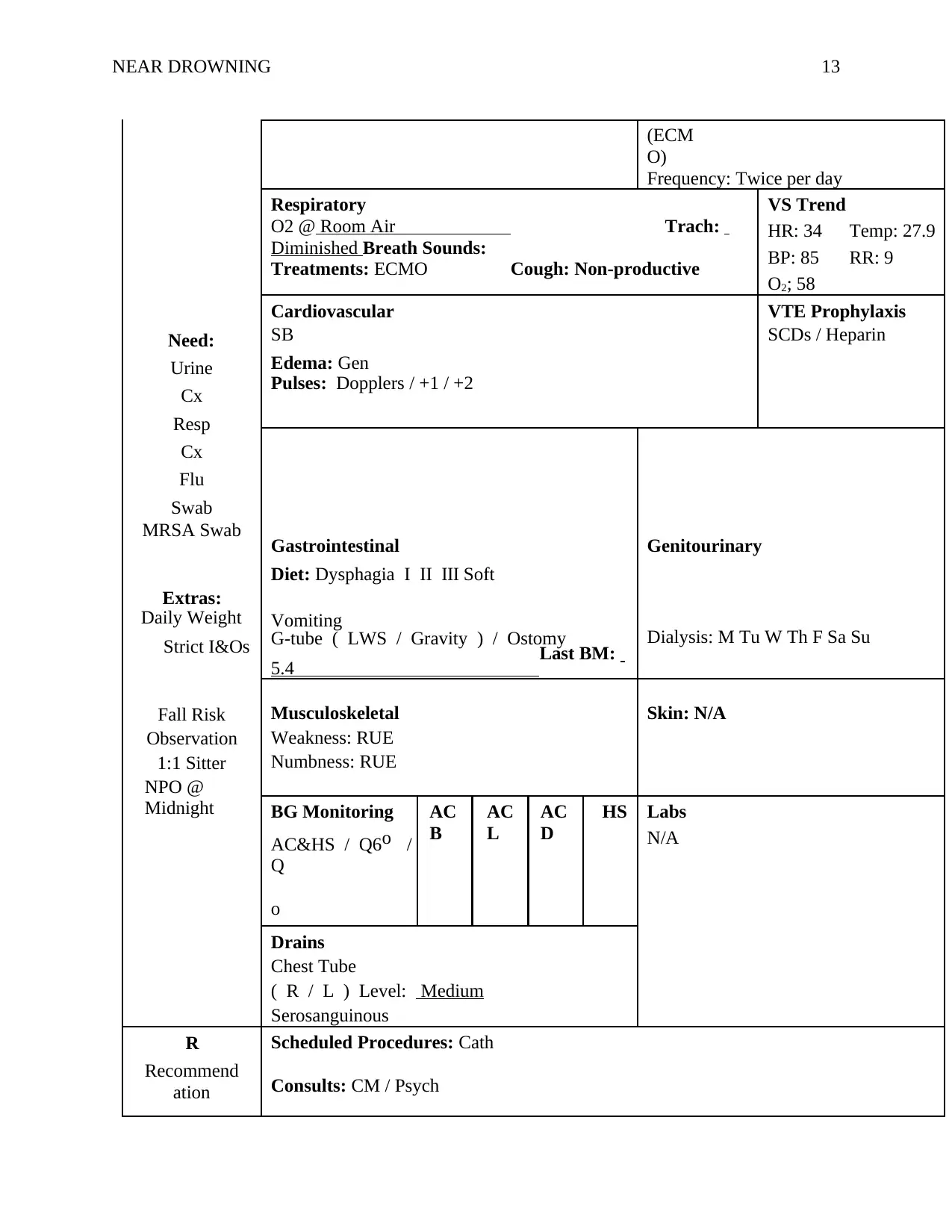
NEAR DROWNING 13
(ECM
O)
Frequency: Twice per day
Respiratory
O2 @ Room Air Trach:
Diminished Breath Sounds:
Treatments: ECMO Cough: Non-productive
VS Trend
HR: 34 Temp: 27.9
BP: 85 RR: 9
O2; 58
Cardiovascular VTE Prophylaxis
Need:
Urine
Cx
Resp
Cx
Flu
Swab
MRSA Swab
SB
Edema: Gen
Pulses: Dopplers / +1 / +2
SCDs / Heparin
Gastrointestinal Genitourinary
Extras:
Diet: Dysphagia I II III Soft
Daily Weight Vomiting
Strict I&Os G-tube ( LWS / Gravity ) / Ostomy
Last BM:
5.4
Dialysis: M Tu W Th F Sa Su
Fall Risk Musculoskeletal Skin: N/A
Observation Weakness: RUE
1:1 Sitter Numbness: RUE
NPO @
Midnight BG Monitoring
AC&HS / Q6o /
Q
o
AC
B
AC
L
AC
D
HS Labs
N/A
Drains
Chest Tube
( R / L ) Level: Medium
Serosanguinous
R
Recommend
ation
Scheduled Procedures: Cath
Consults: CM / Psych
(ECM
O)
Frequency: Twice per day
Respiratory
O2 @ Room Air Trach:
Diminished Breath Sounds:
Treatments: ECMO Cough: Non-productive
VS Trend
HR: 34 Temp: 27.9
BP: 85 RR: 9
O2; 58
Cardiovascular VTE Prophylaxis
Need:
Urine
Cx
Resp
Cx
Flu
Swab
MRSA Swab
SB
Edema: Gen
Pulses: Dopplers / +1 / +2
SCDs / Heparin
Gastrointestinal Genitourinary
Extras:
Diet: Dysphagia I II III Soft
Daily Weight Vomiting
Strict I&Os G-tube ( LWS / Gravity ) / Ostomy
Last BM:
5.4
Dialysis: M Tu W Th F Sa Su
Fall Risk Musculoskeletal Skin: N/A
Observation Weakness: RUE
1:1 Sitter Numbness: RUE
NPO @
Midnight BG Monitoring
AC&HS / Q6o /
Q
o
AC
B
AC
L
AC
D
HS Labs
N/A
Drains
Chest Tube
( R / L ) Level: Medium
Serosanguinous
R
Recommend
ation
Scheduled Procedures: Cath
Consults: CM / Psych
Paraphrase This Document
Need a fresh take? Get an instant paraphrase of this document with our AI Paraphraser

NEAR DROWNING 14
Discharge to: Home
Discharge to: Home
1 out of 14
Your All-in-One AI-Powered Toolkit for Academic Success.
+13062052269
info@desklib.com
Available 24*7 on WhatsApp / Email
![[object Object]](/_next/static/media/star-bottom.7253800d.svg)
Unlock your academic potential
© 2024 | Zucol Services PVT LTD | All rights reserved.